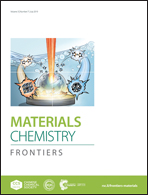Ionic liquid crystals with aggregation-induced emission properties based on pyrrolo[3,2-b]pyrrole salt compounds†
Abstract
The present work reports the synthesis, optical properties and mesomorphism of two viologen derivatives DPP-2Py-9 and DPP-2Py-5 of 4,4′-((2,5-diphenylpyrrolo[3,2-b]pyrrole-1,4-diyl)bis(4,1-phenylene))bis(1-pyridin-1-ium) 4-toluenesulfonate. Both DPP-2Py-5 and DPP-2Py-9 showed aggregation-induced emission (AIE) characteristics indicating that the phenyl pyrrolo[3,2-b]pyrrole core acts as an AIE unit in their salt compounds. DPP-2Py-5 did not show liquid crystalline properties due to the shorter alkoxy chains. DPP-2Py-9 was a liquid crystalline compound with smectic A mesophase, showing marble-like textures observed at 185 °C during the cooling process. DPP-2Py-9 exhibited different emission behaviors in different aggregation states controlled by the change of temperature. The PL intensity of DPP-2Py-9 gradually decreased and the wavelength showed a hypochromic shift as the temperature increased. The most obvious variation of the wavelength occurred in the liquid crystalline range. The liquid crystalline temperature range between 185 and 210 °C determined by the differential curve of PL wavelength vs. temperature was similar to that measured by the DSC technique. Therefore, PL emission spectroscopy could be used as a technical method to characterize the liquid crystalline behaviors.
![Graphical abstract: Ionic liquid crystals with aggregation-induced emission properties based on pyrrolo[3,2-b]pyrrole salt compounds](/en/Image/Get?imageInfo.ImageType=GA&imageInfo.ImageIdentifier.ManuscriptID=C9QM00208A&imageInfo.ImageIdentifier.Year=2019)
- This article is part of the themed collection: Recent Progress on Aggregation-Induced Emission


 Please wait while we load your content...
Please wait while we load your content...